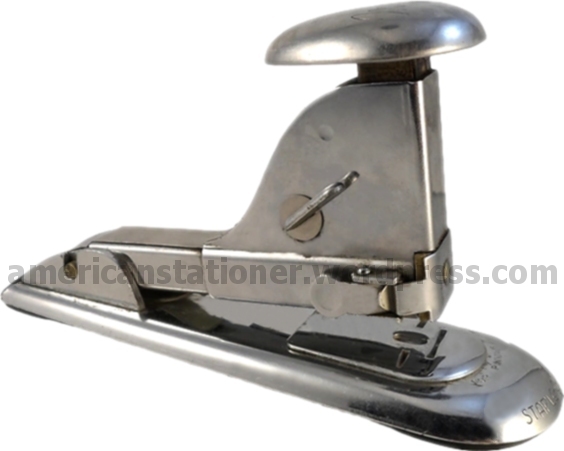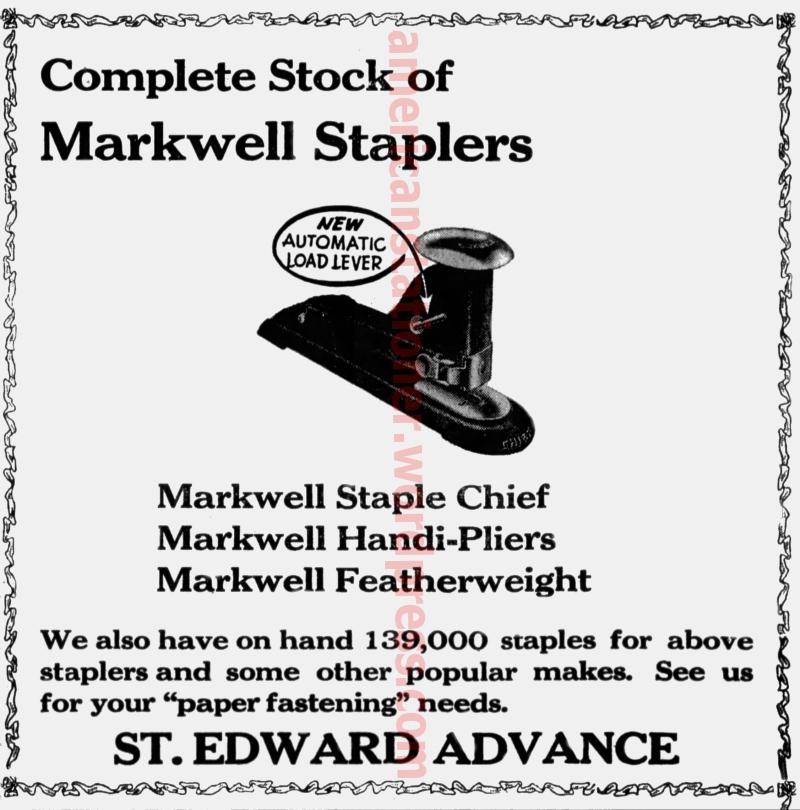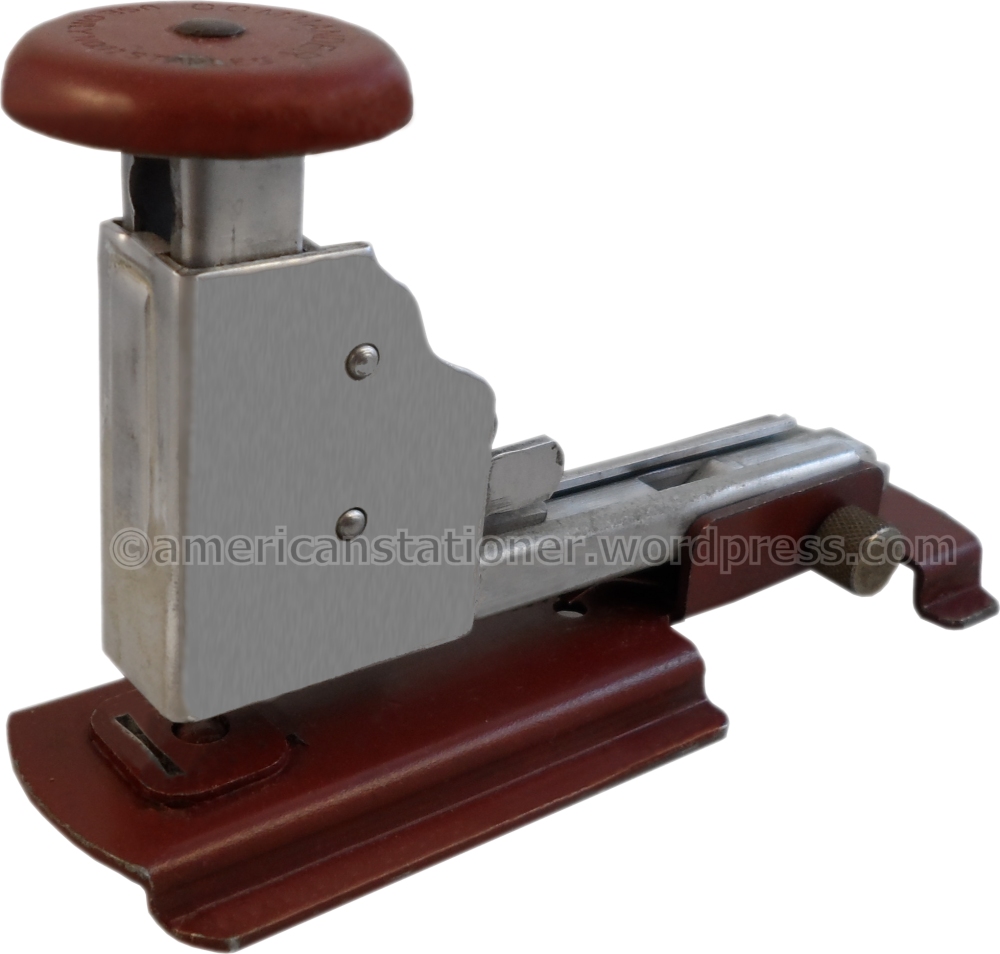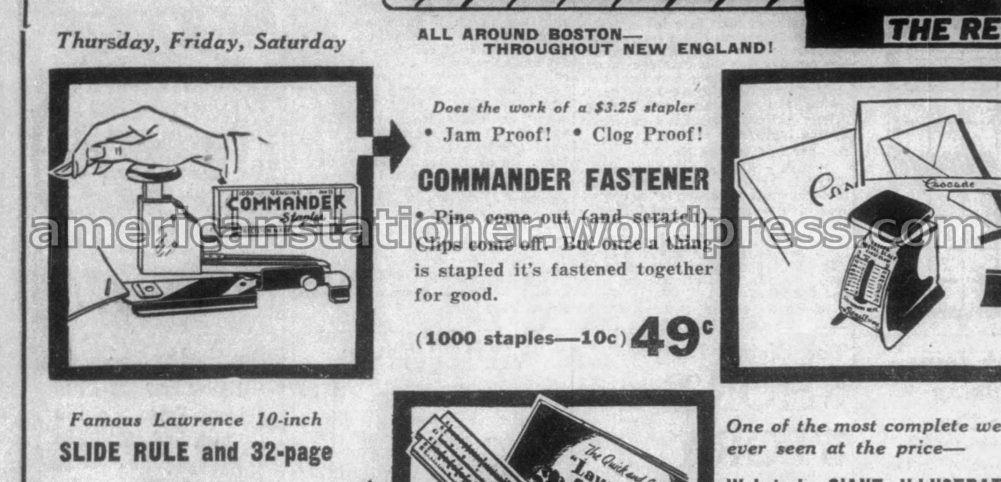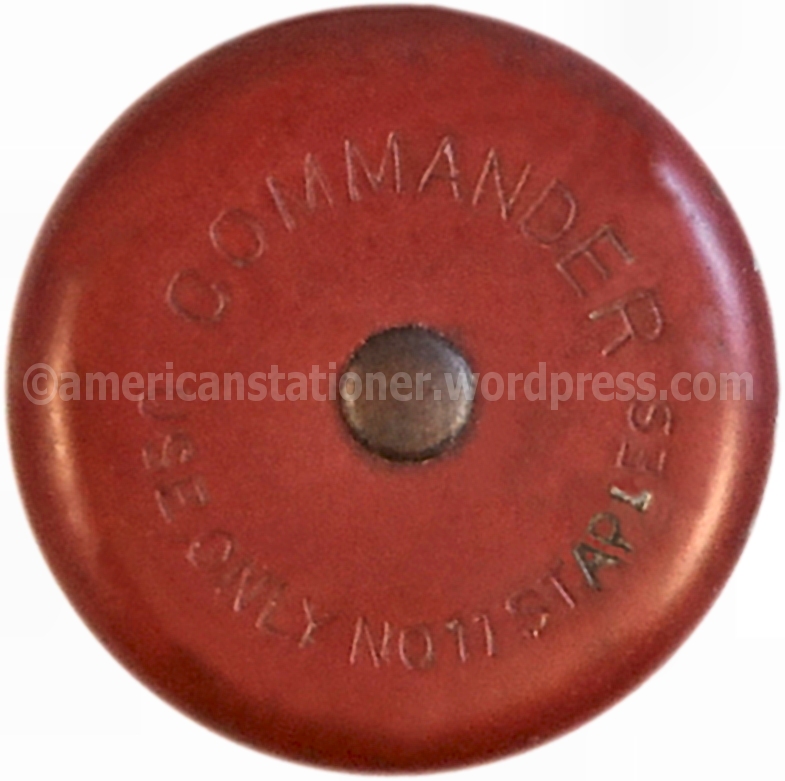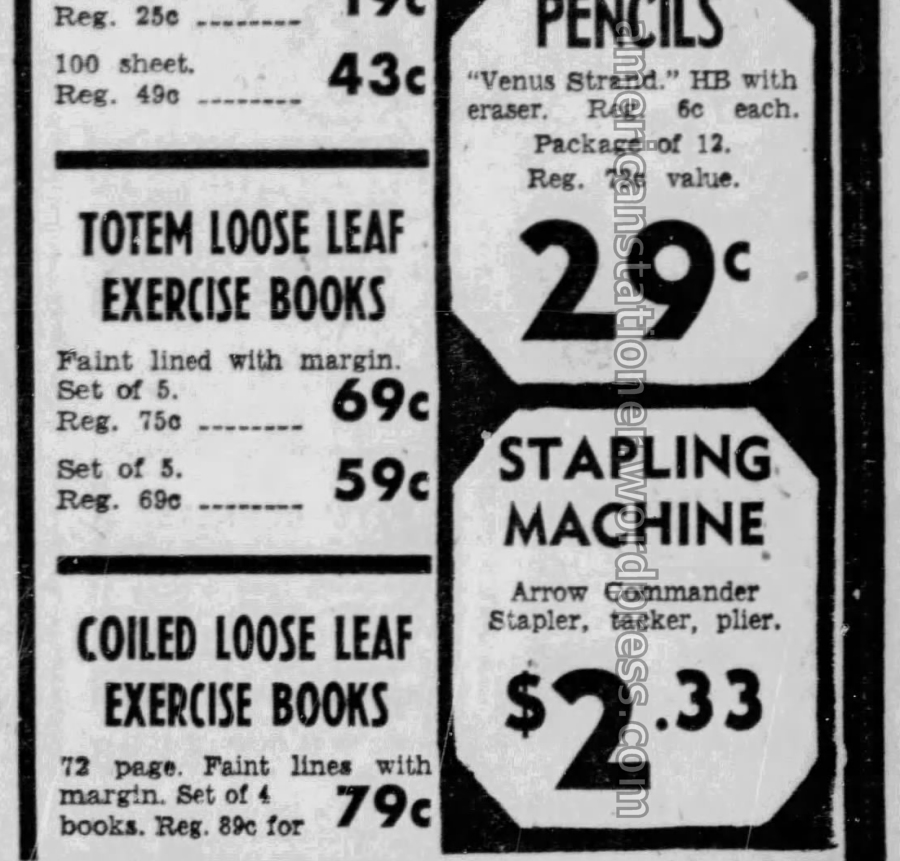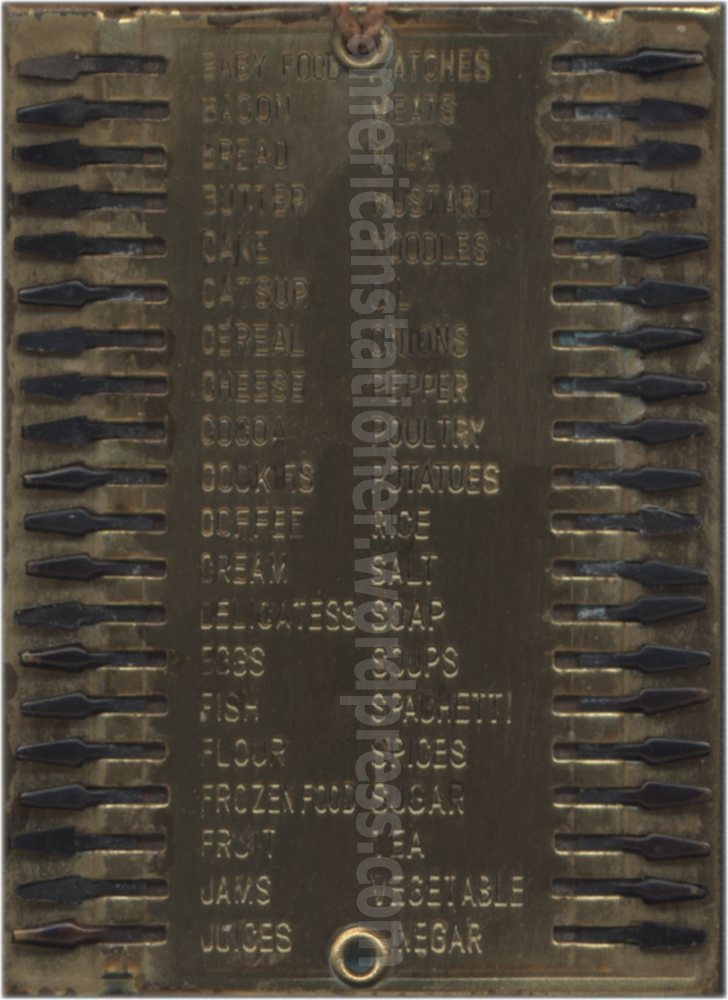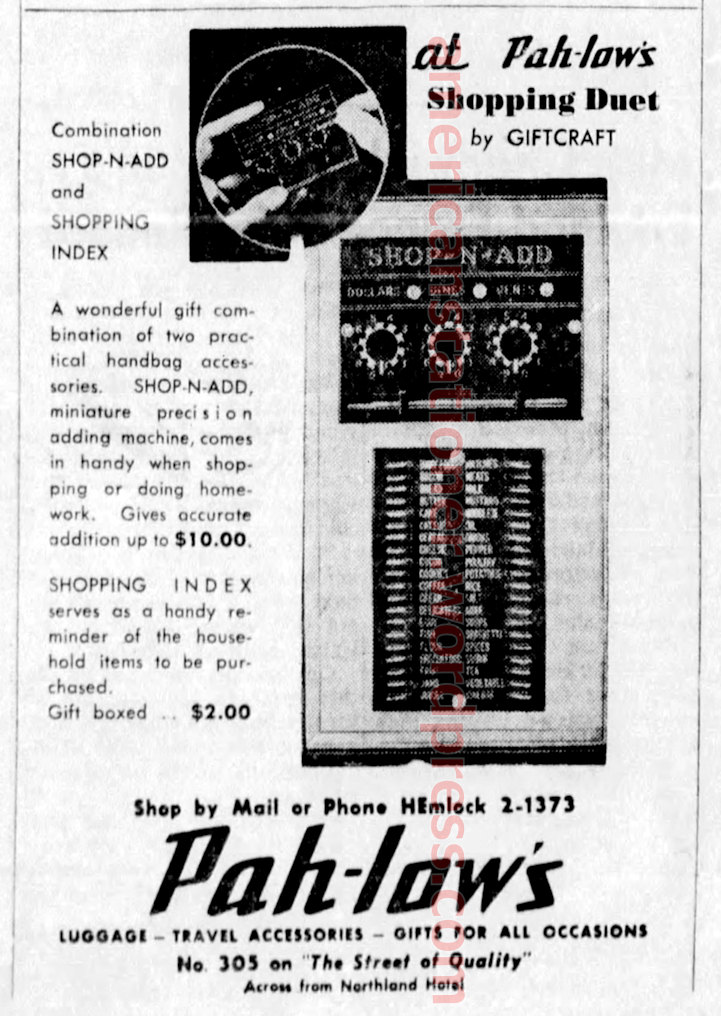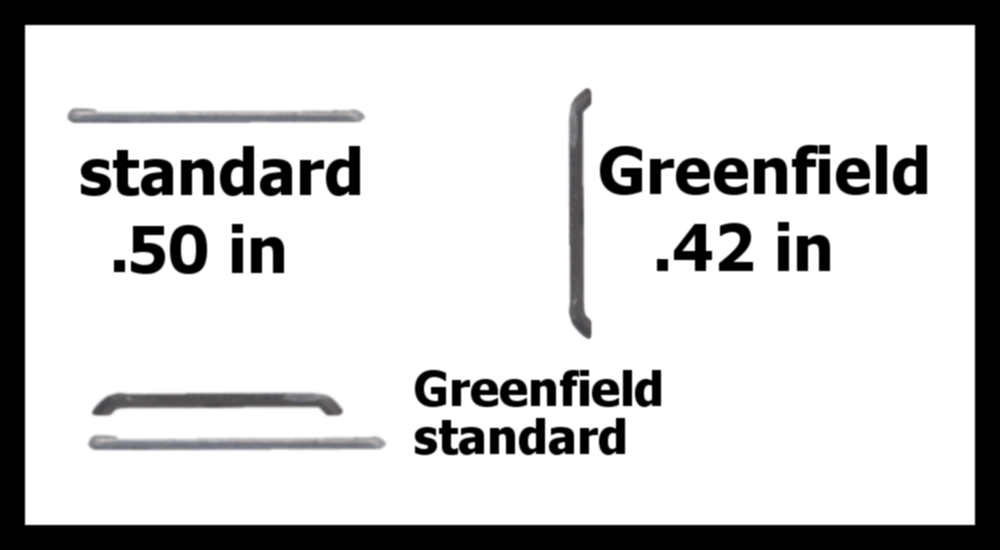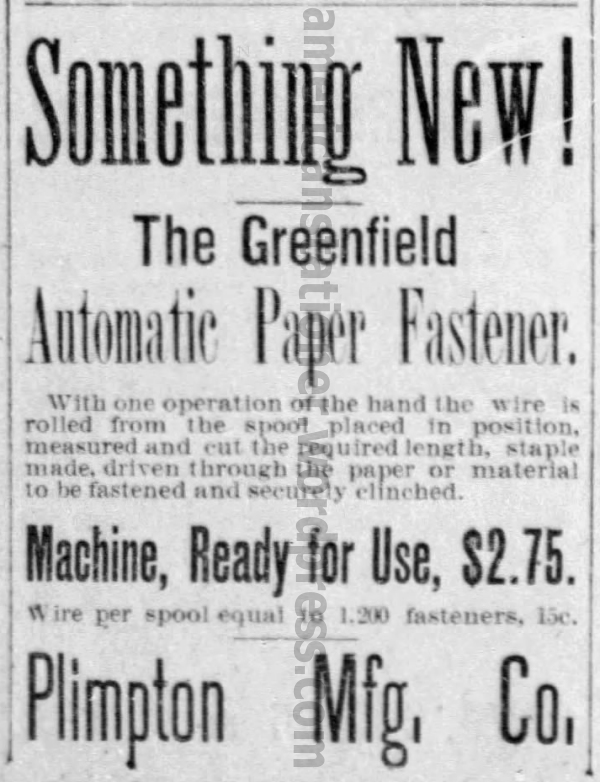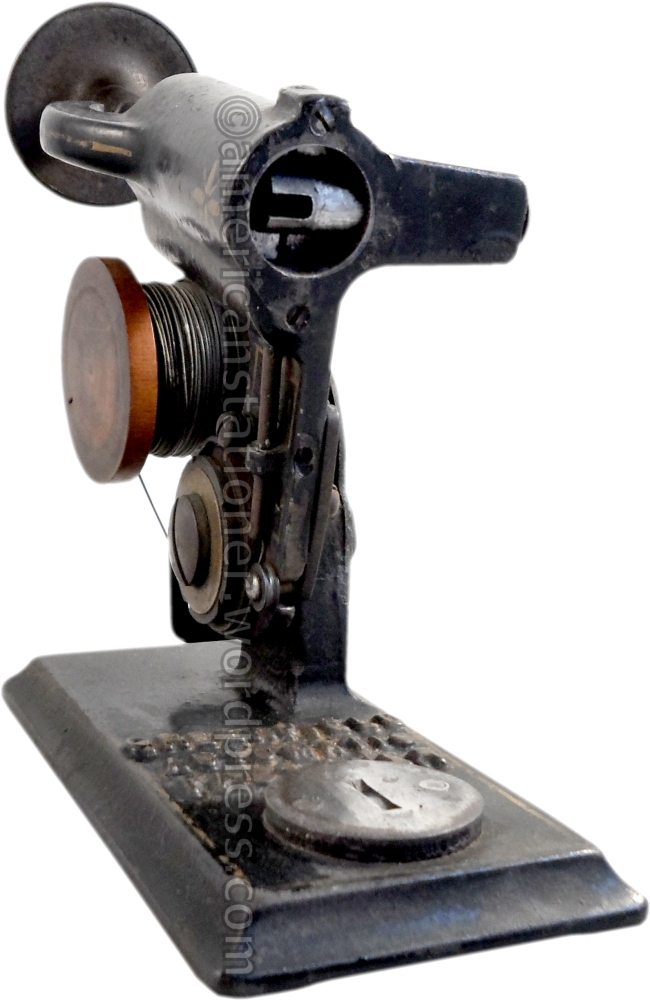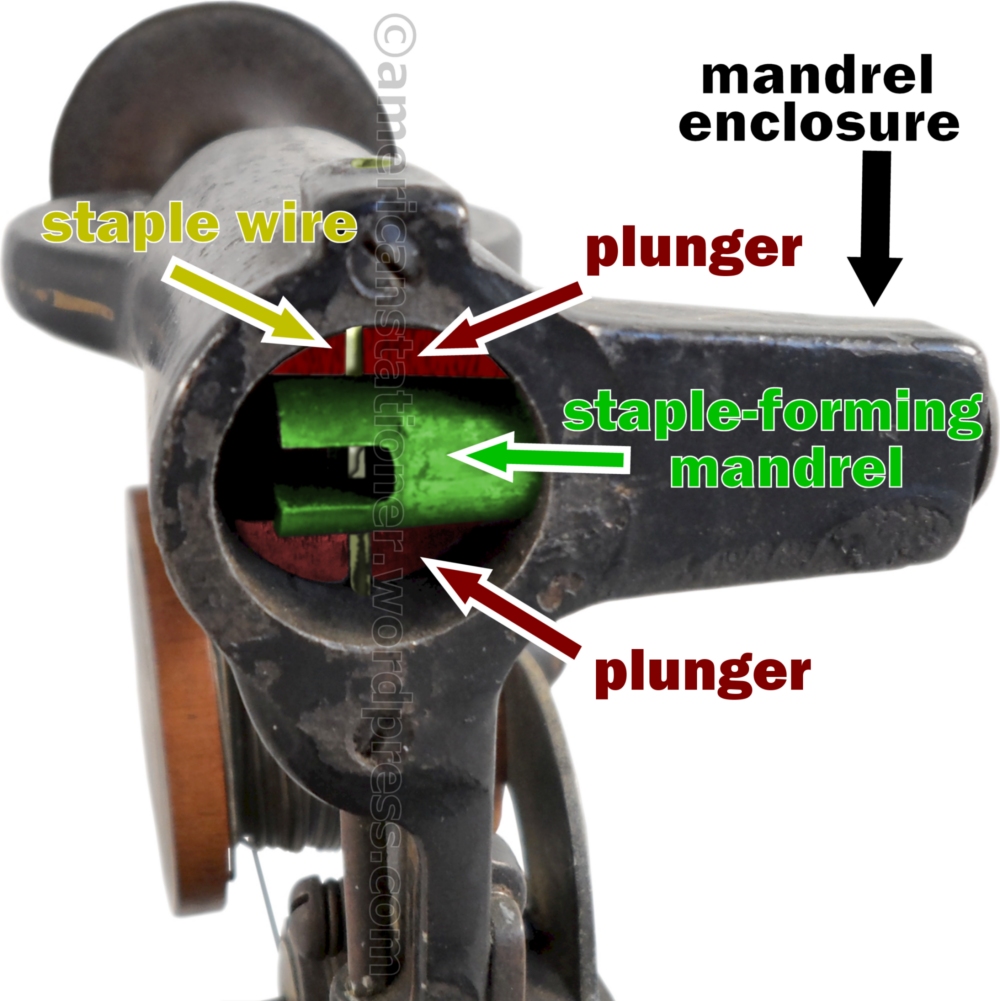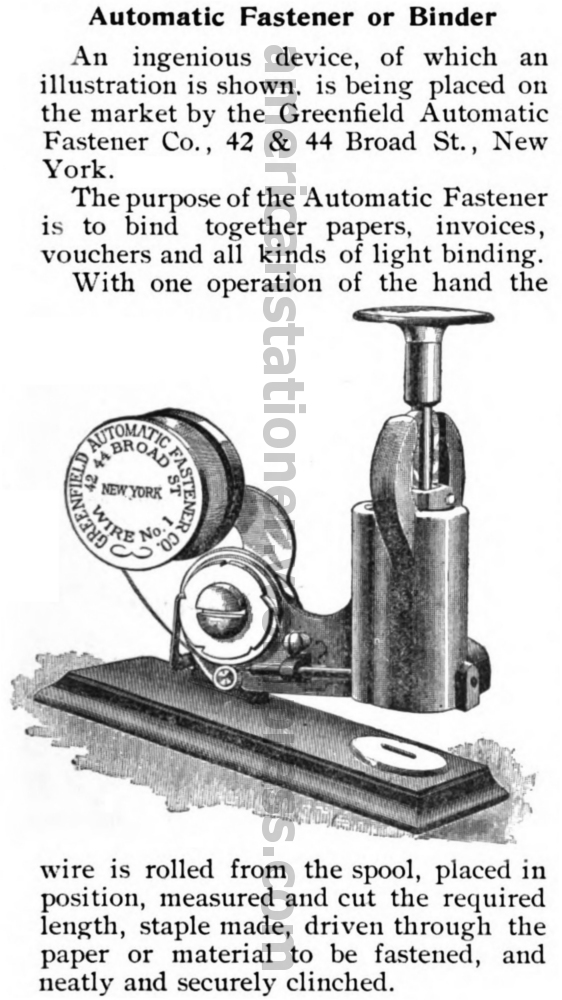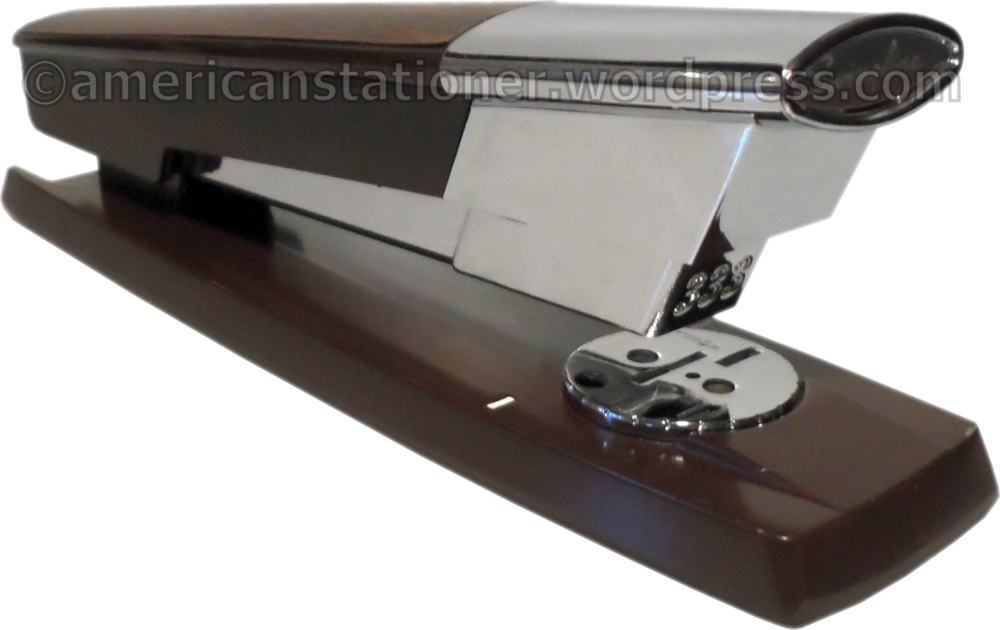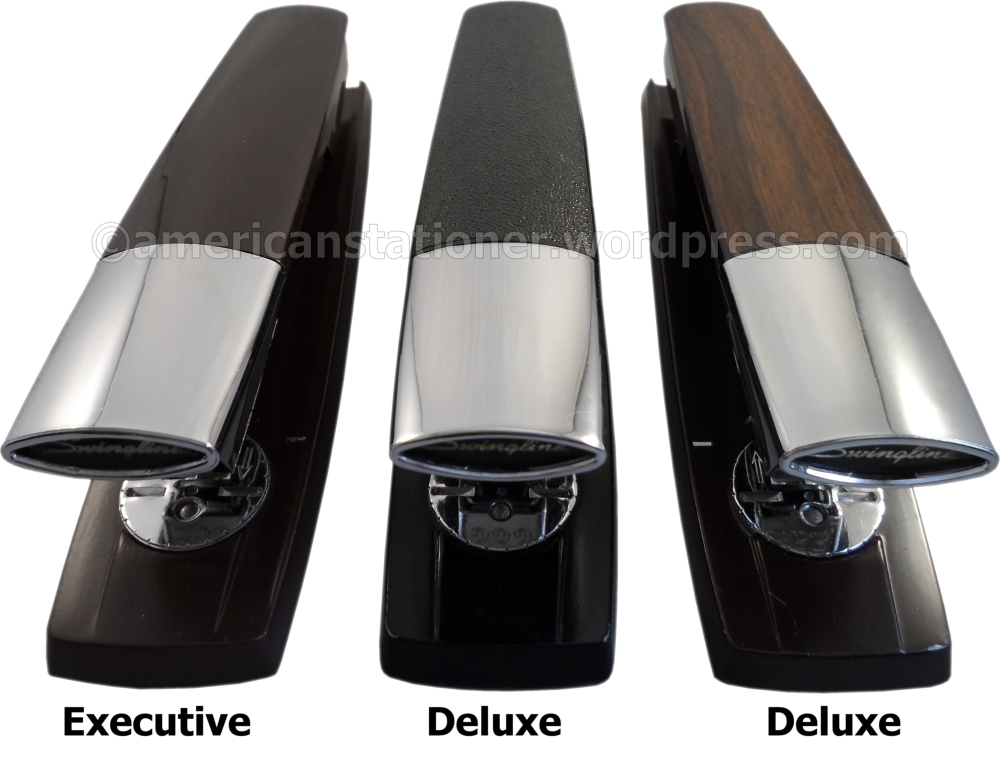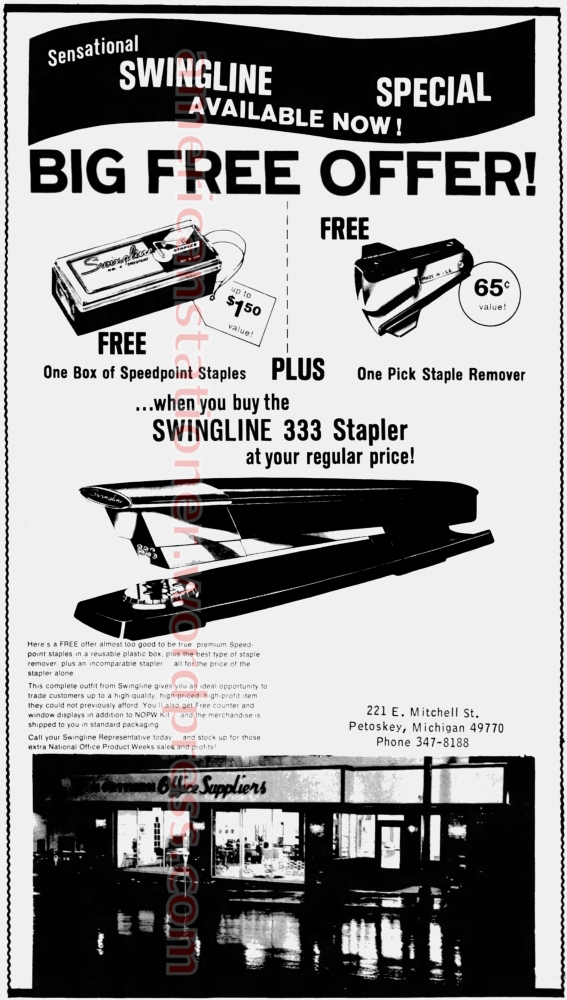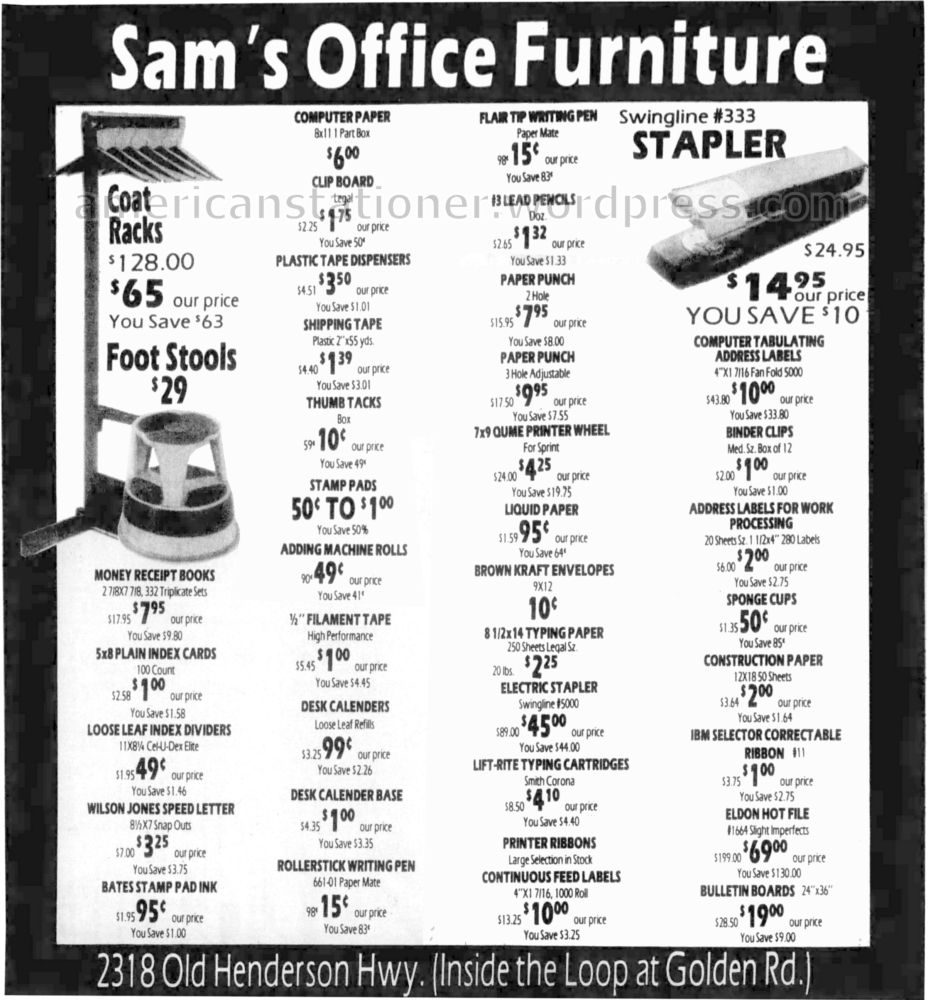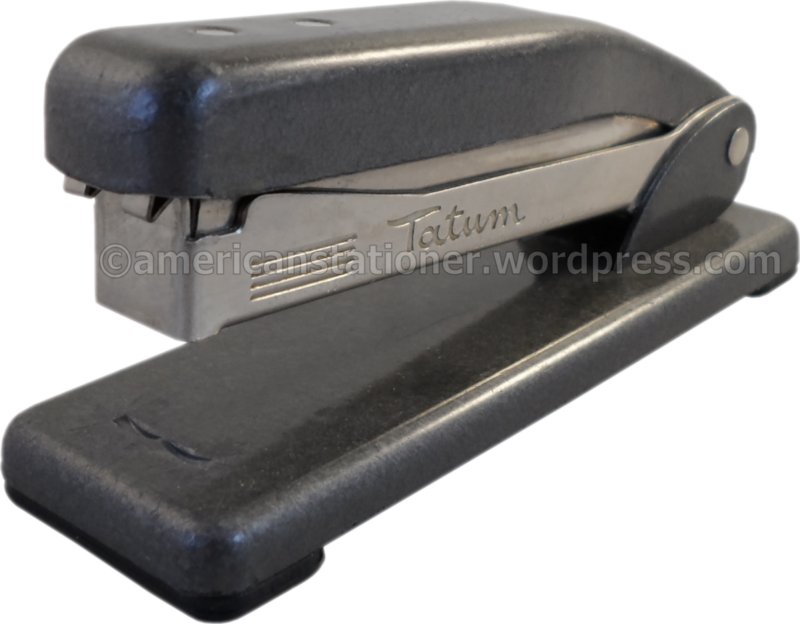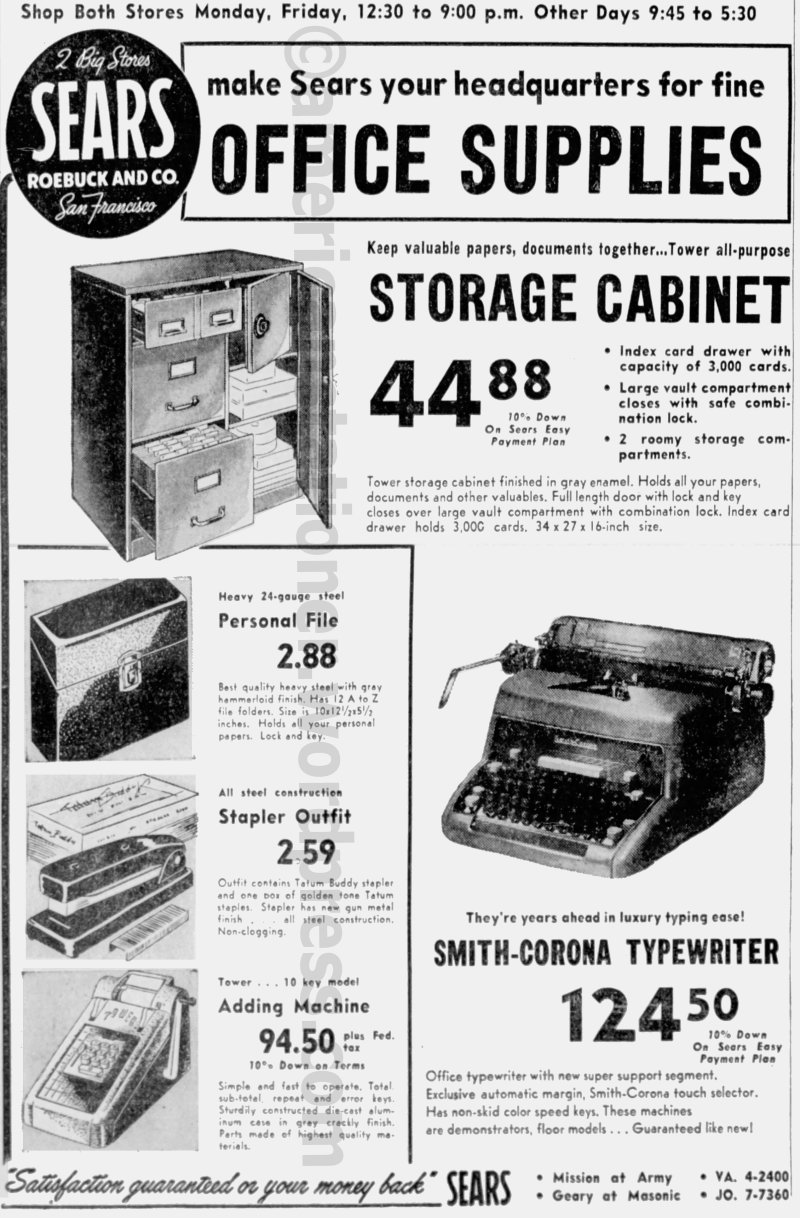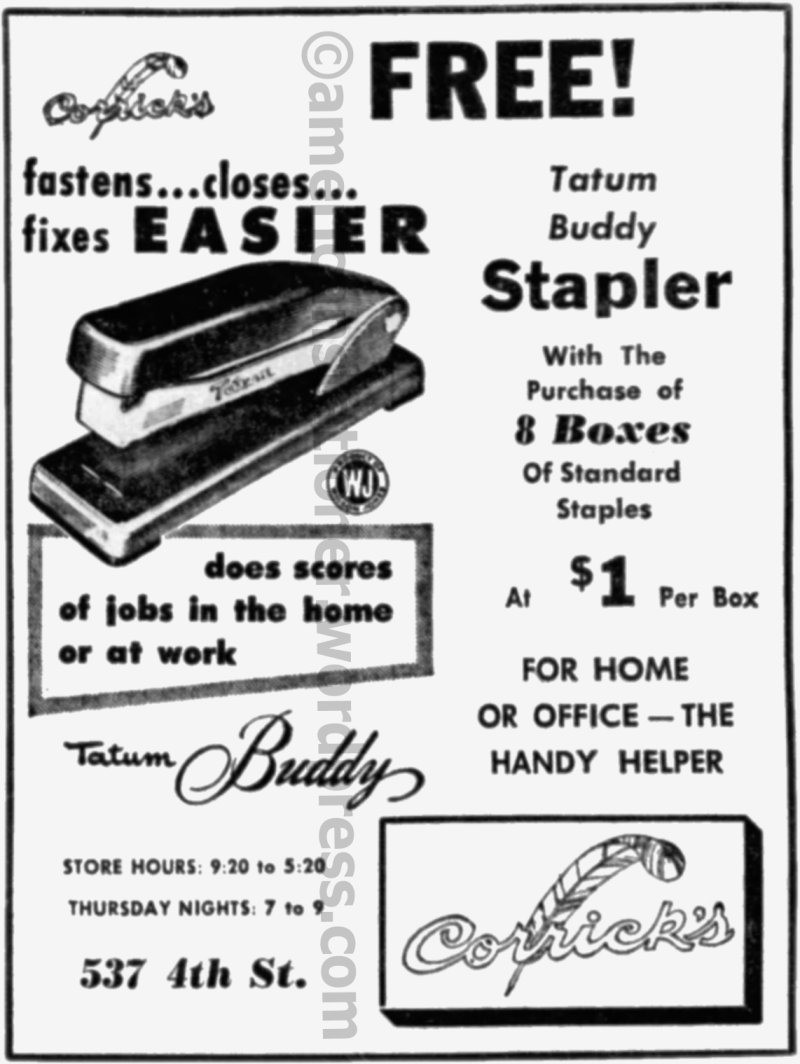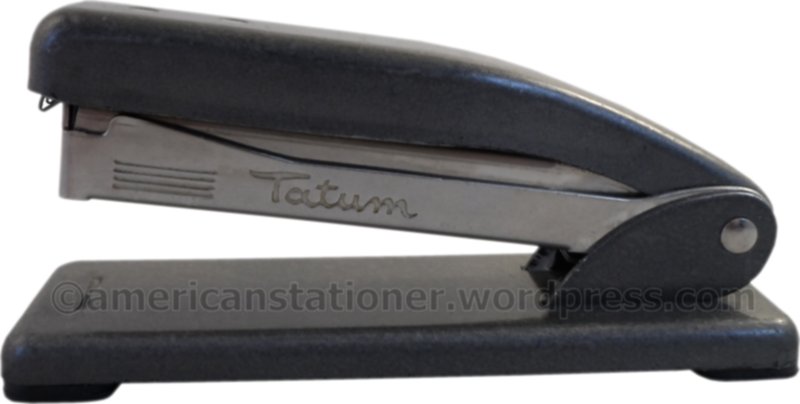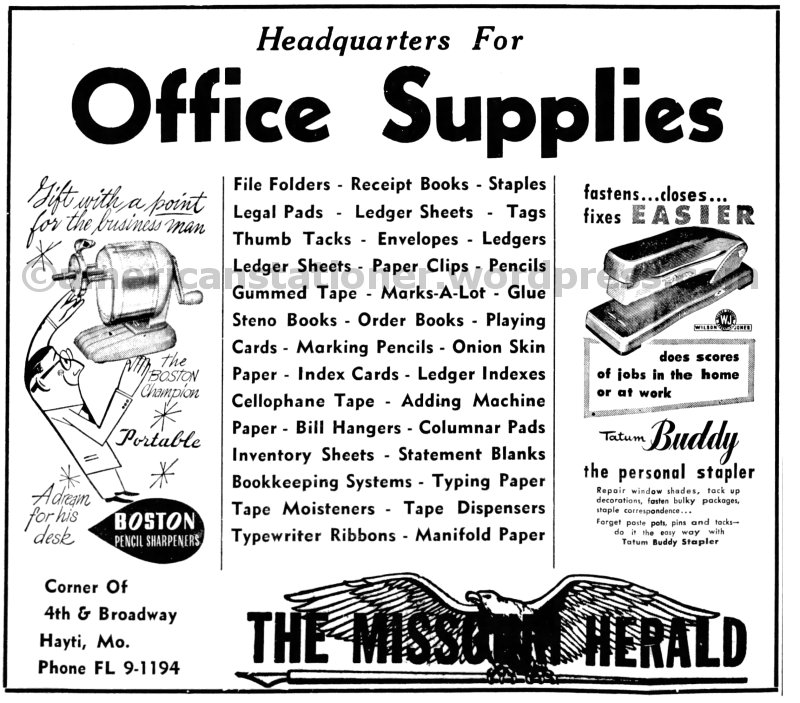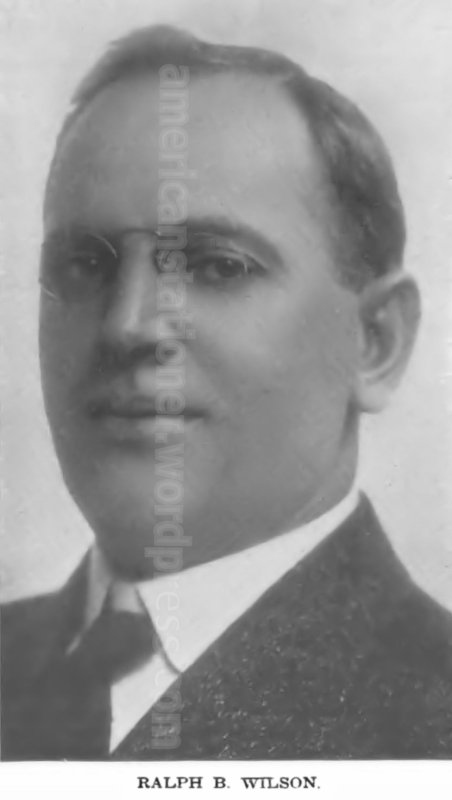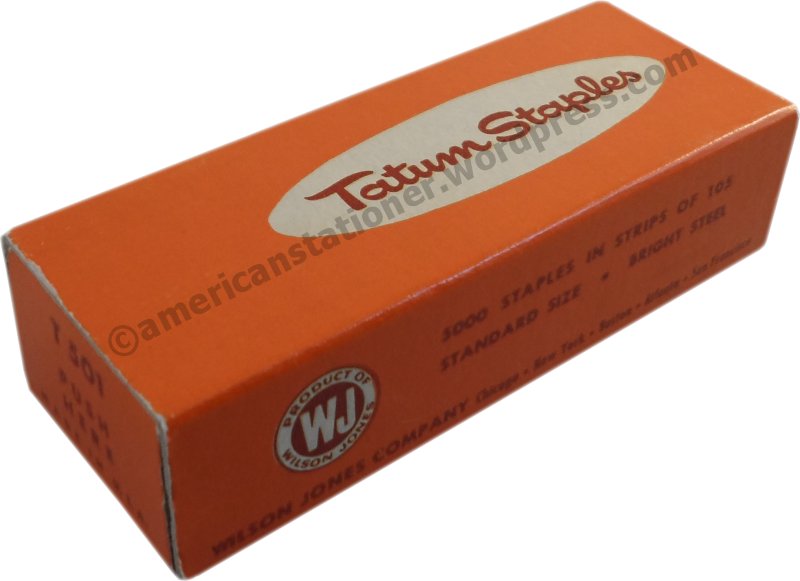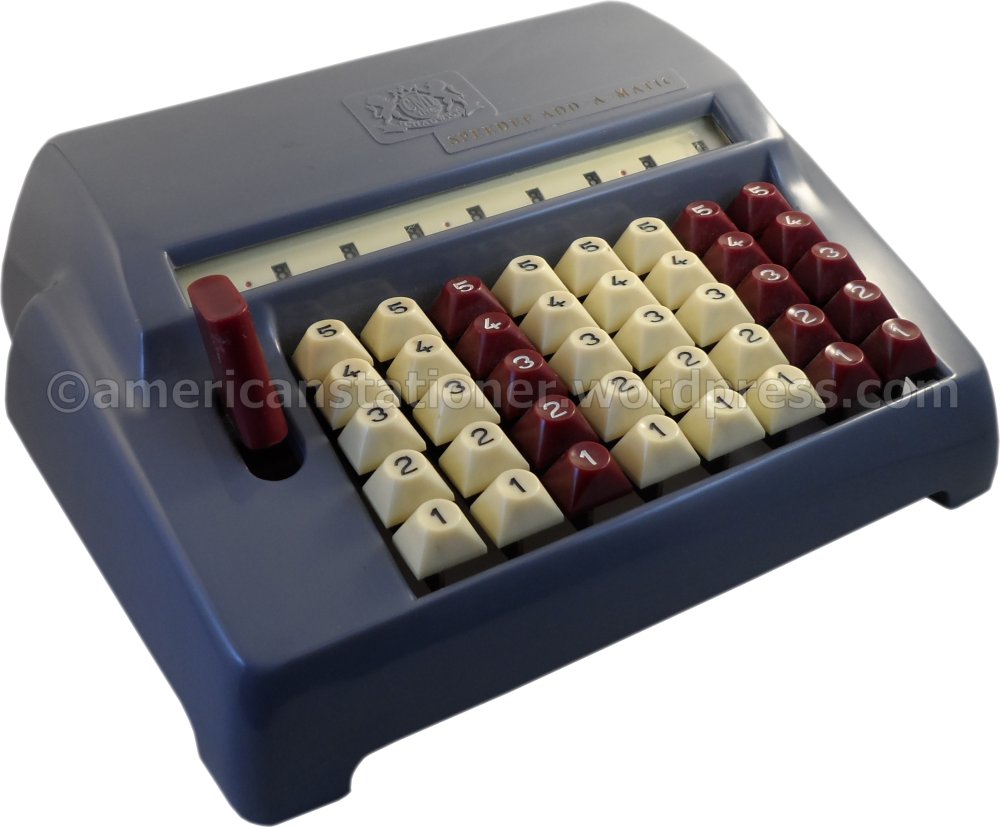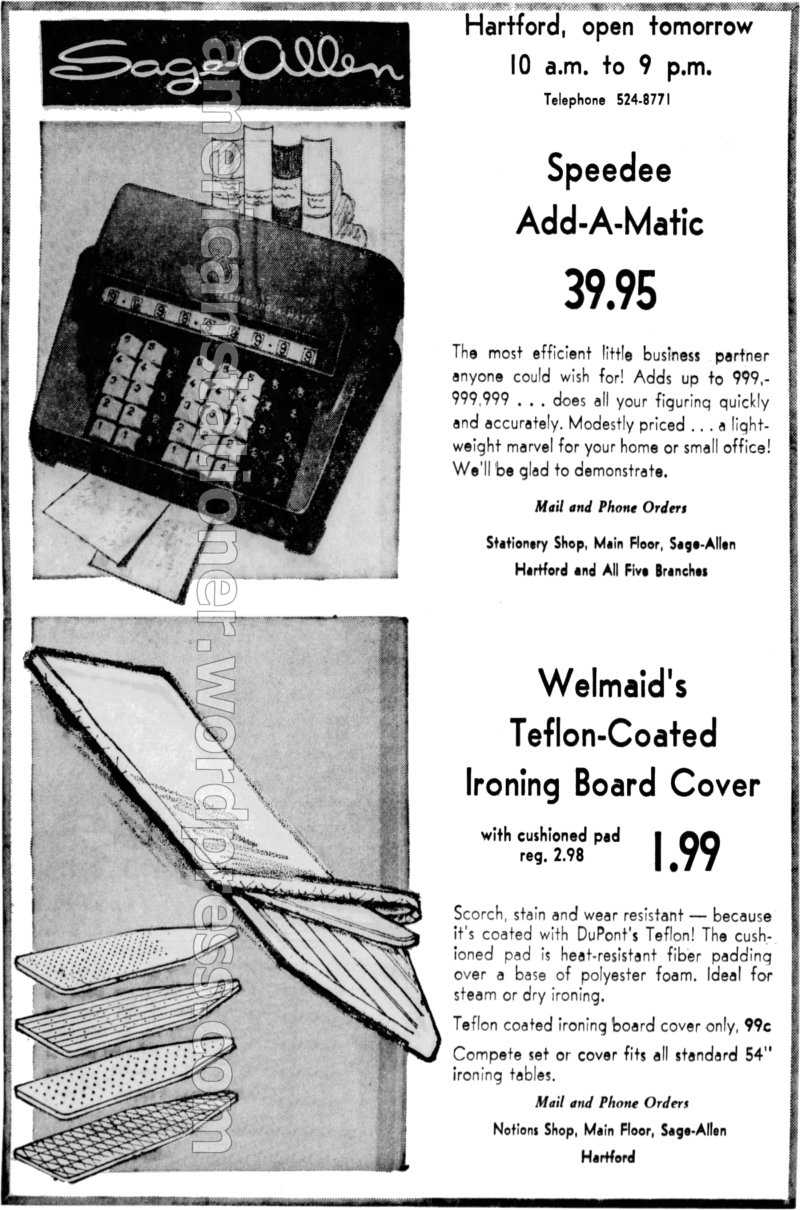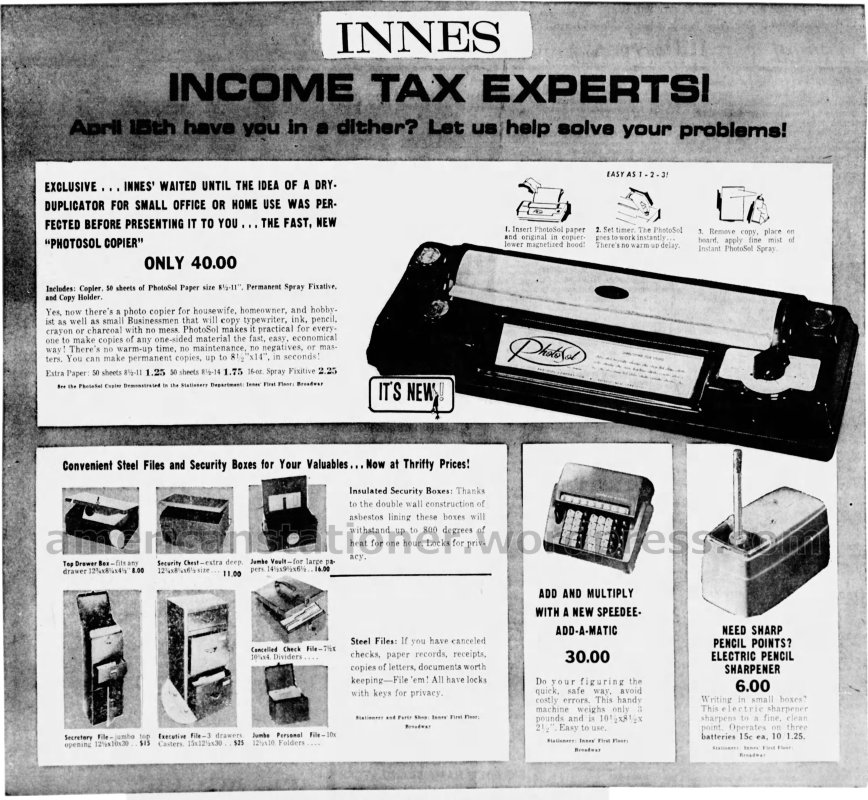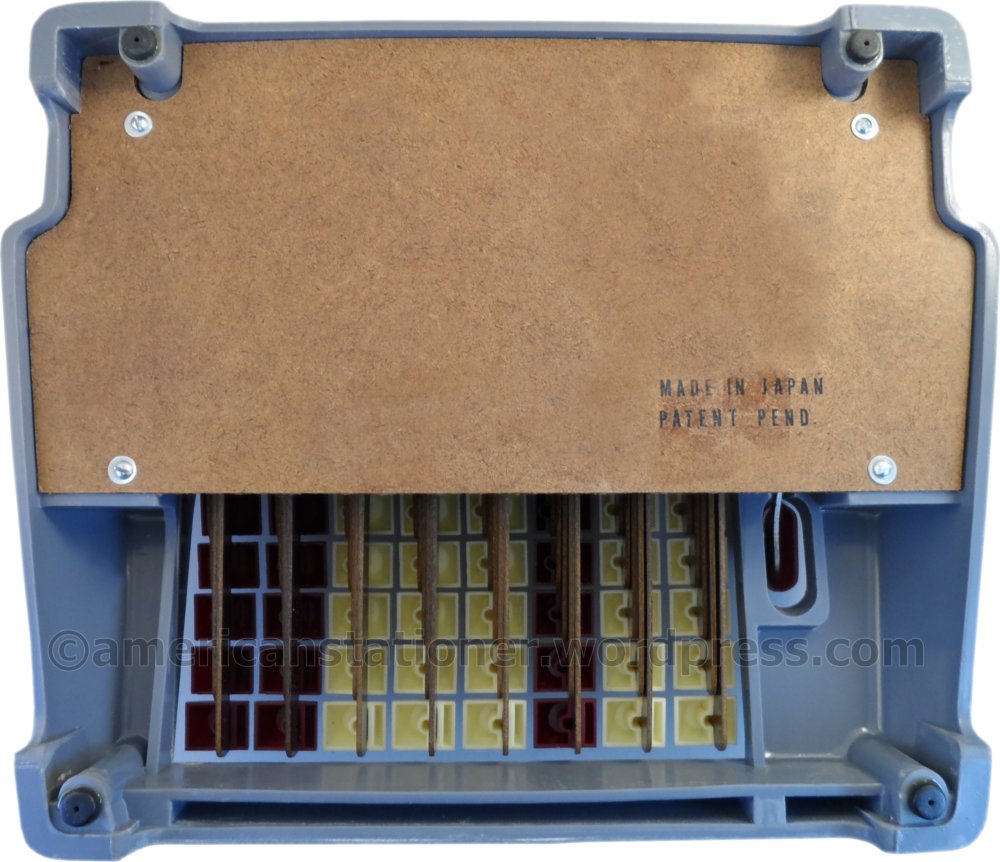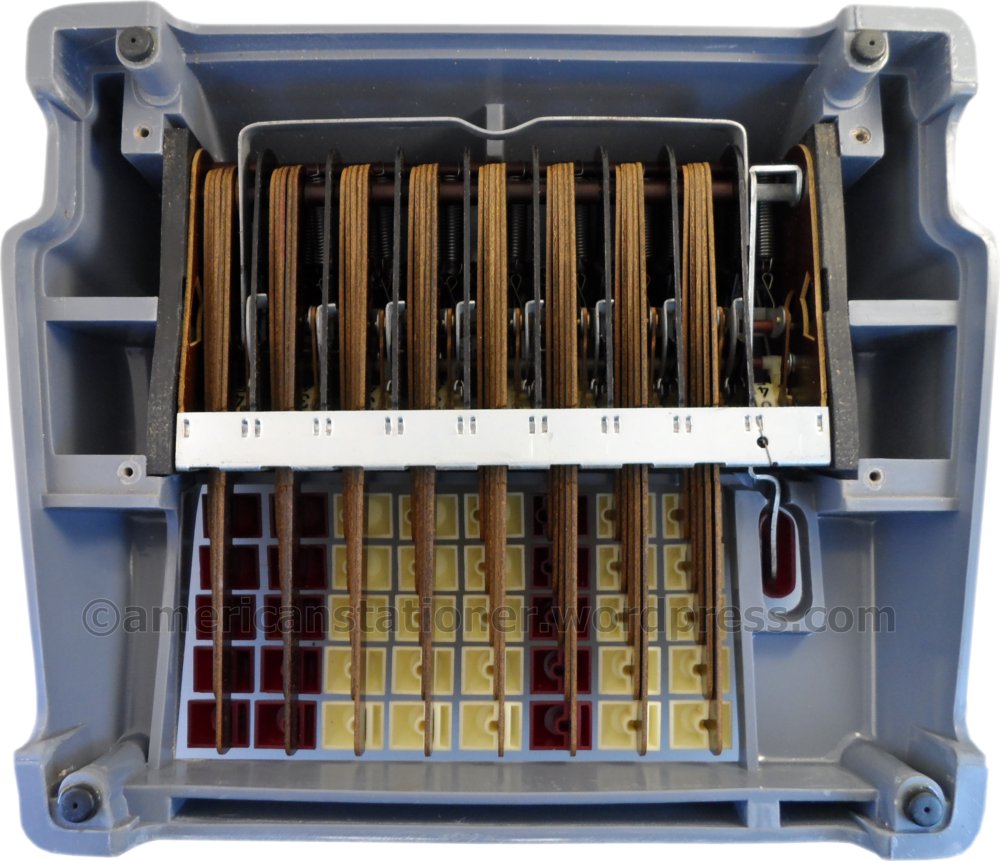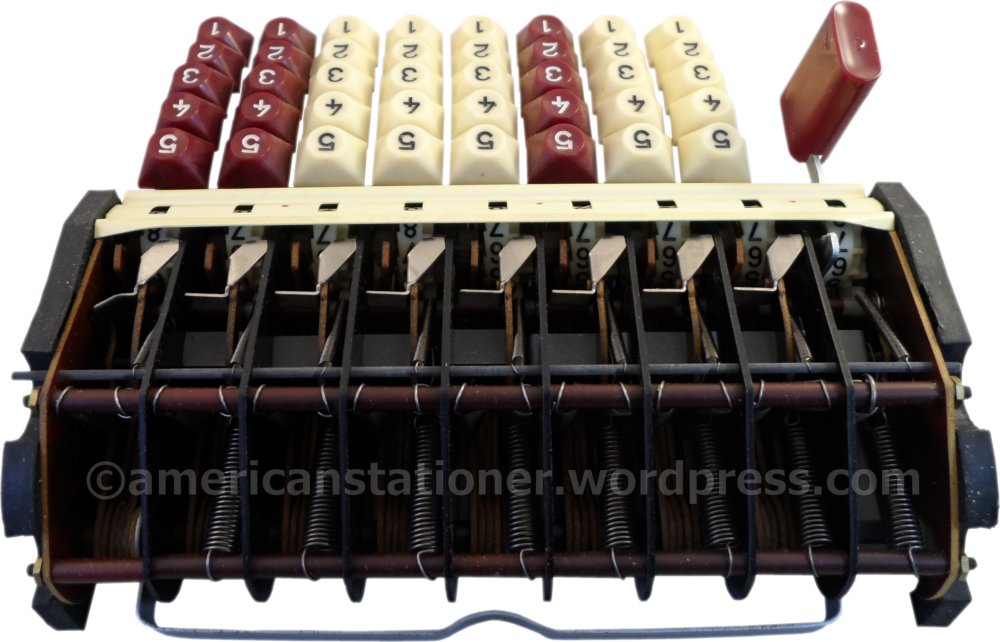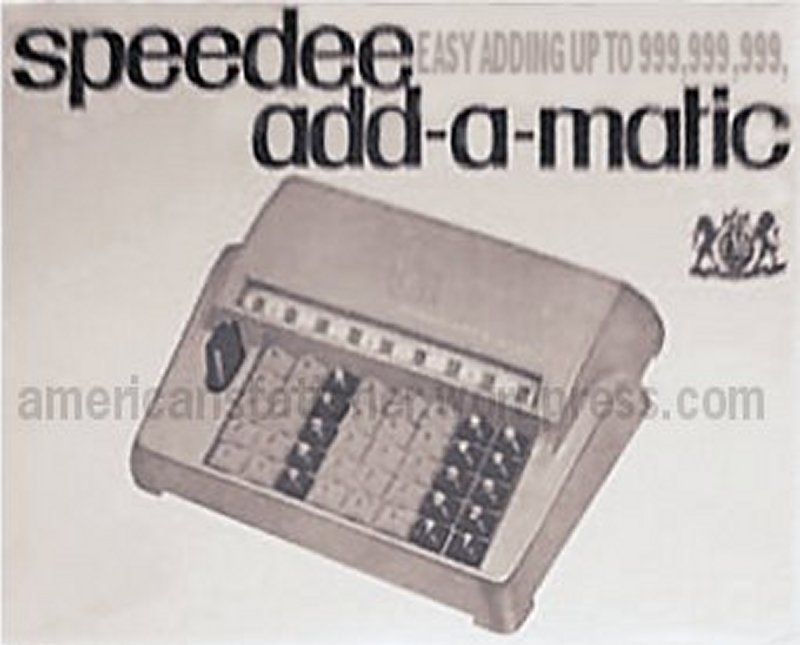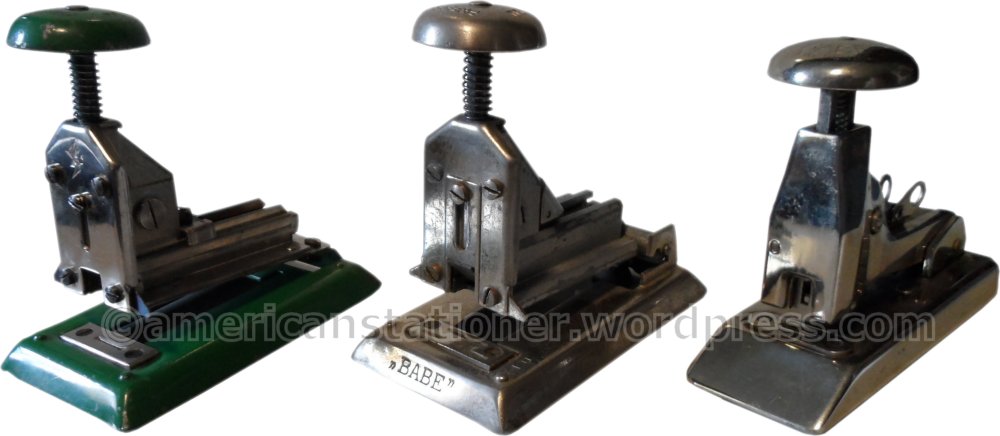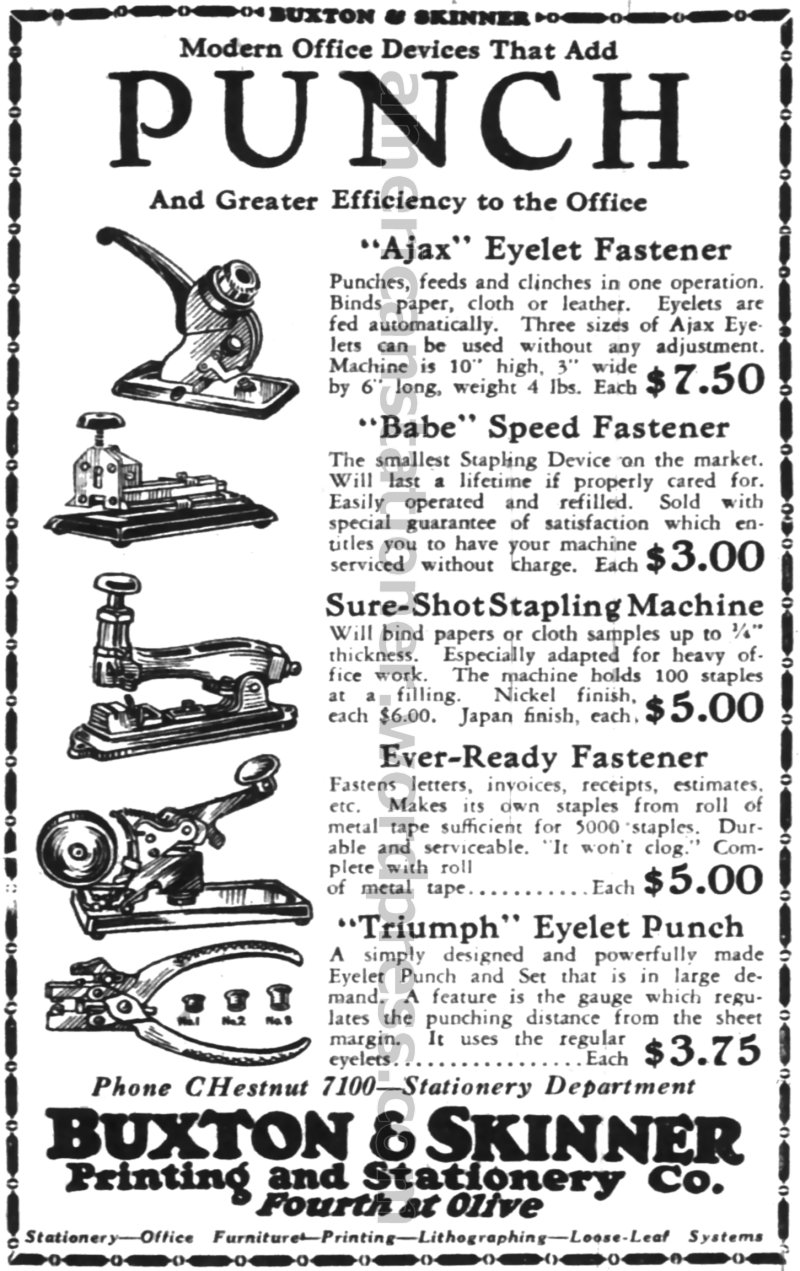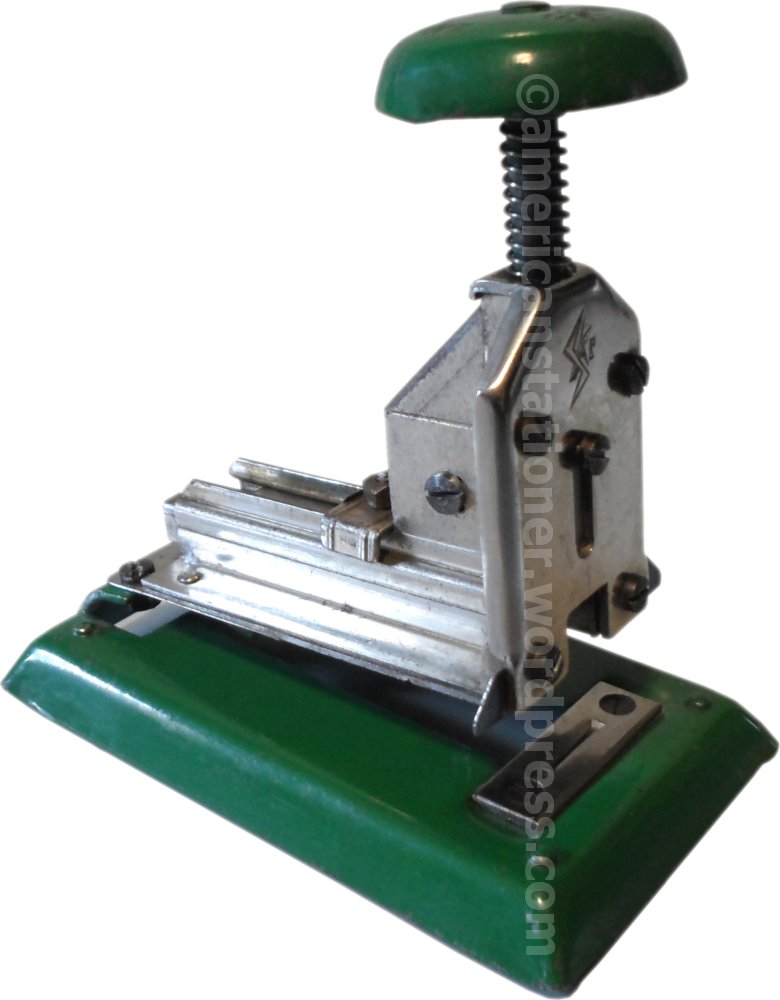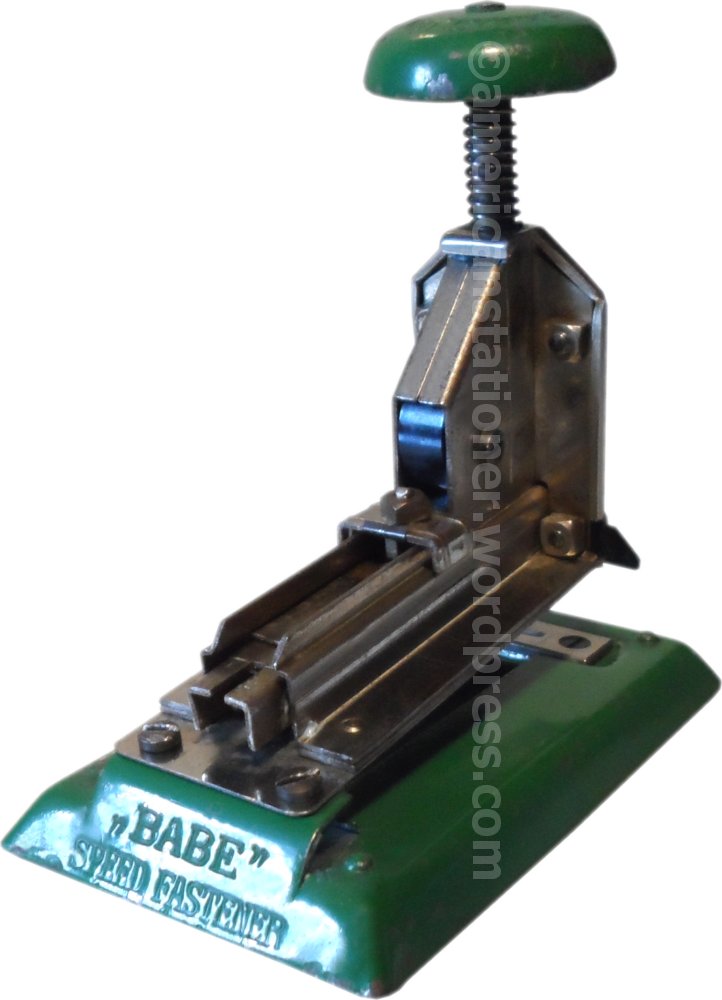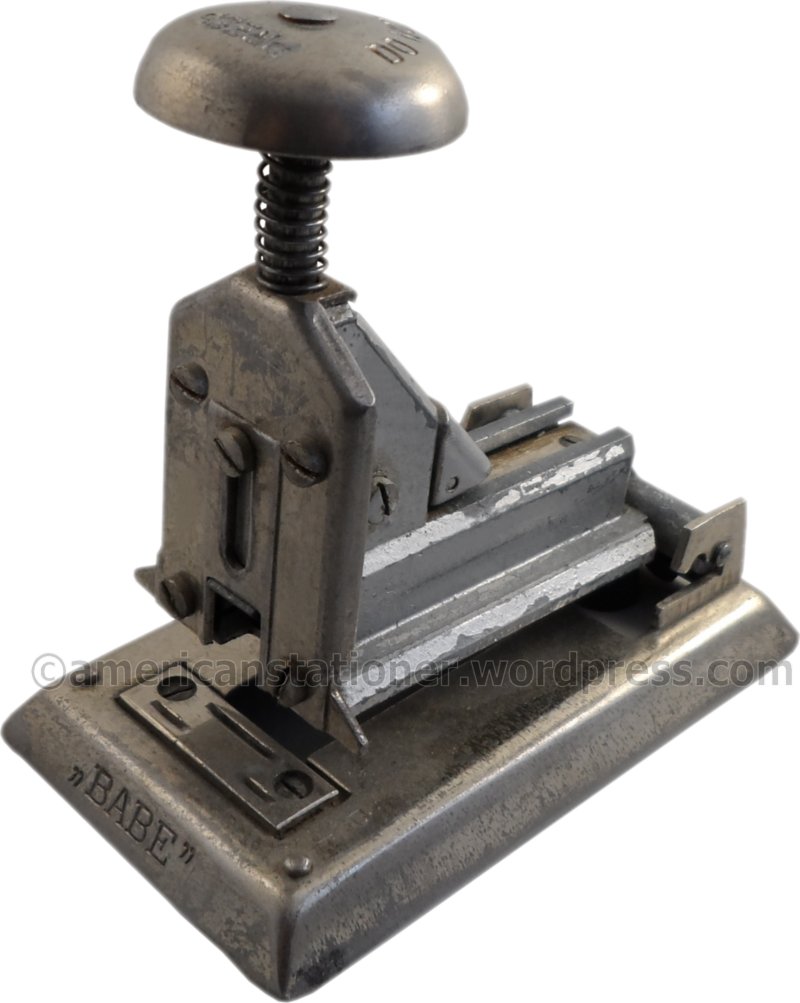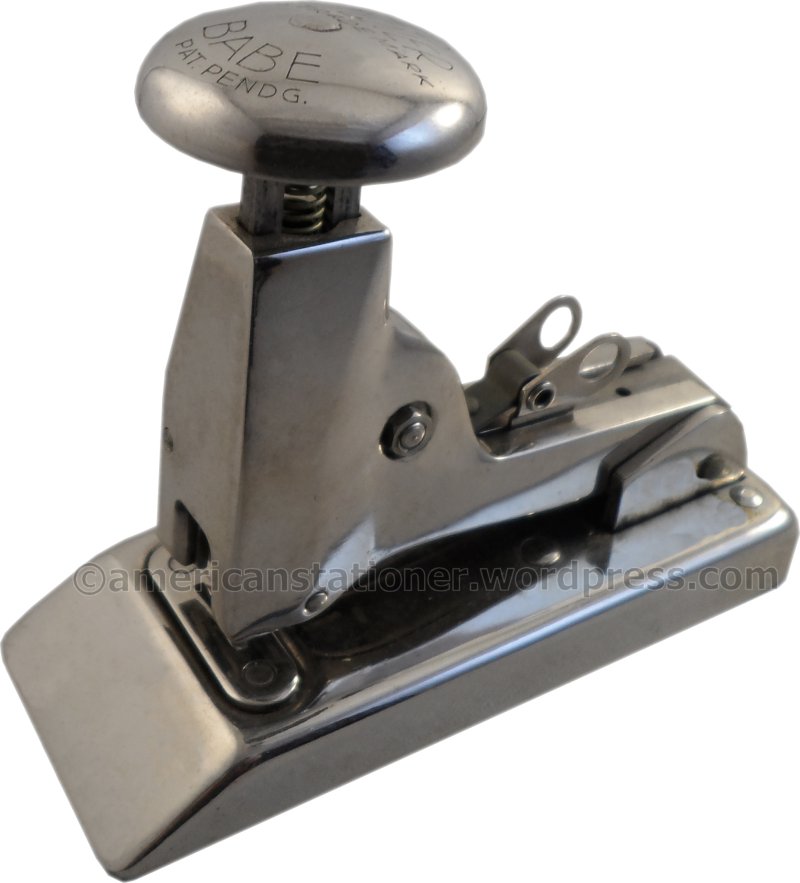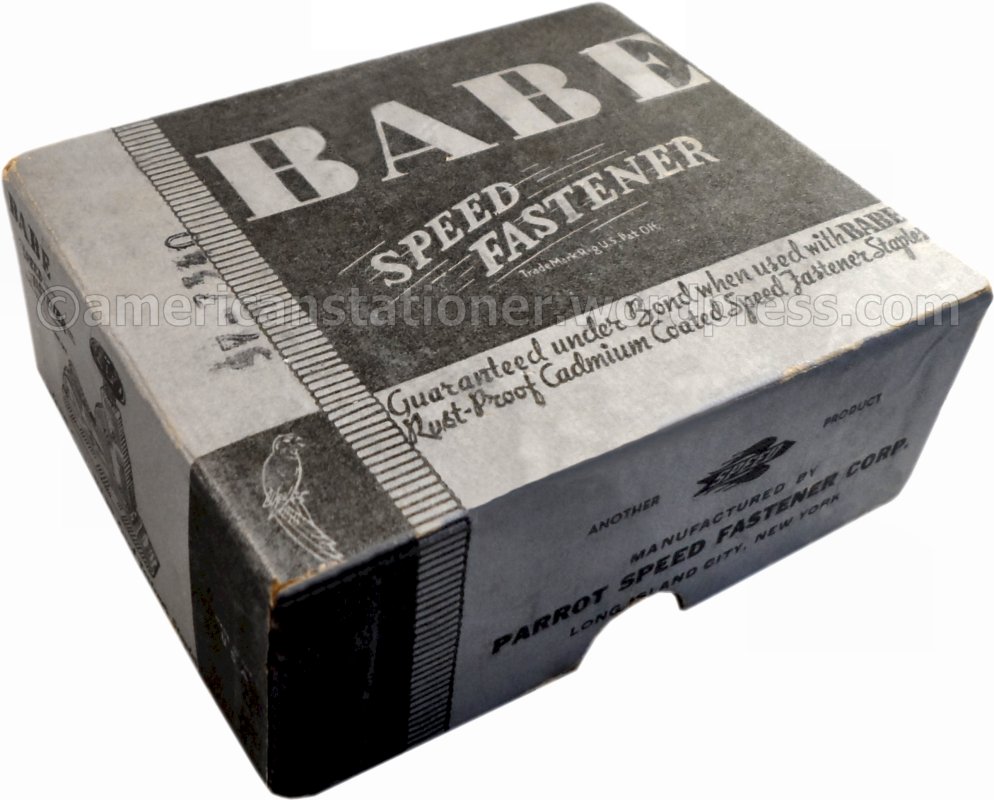
Long before Kakuyo, long before Paper Welder, and long before Mosda, Chadwick, or any of the others, an early green way to fasten papers together was introduced by the Bump Perfected Paper Fastener Company. Introduced in 1910 the Bump Fastener was in direct competition for your desk space from other fasteners such as the Hotchkiss No 1 stapler. While it didn’t have the fastening capacity of the Hotchkiss, what it did bring, or rather didn’t, was the need for any additional supplies such as staples.
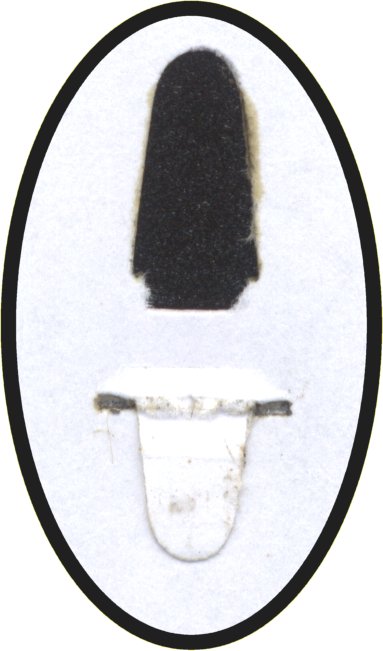
The fastener worked by pressing the handles together (or pushing the plunger cap on the model 2) where it would then perforate, turn, and fold back the created flap into a slot cut near the base of the U-shaped perforation. The models were rated to be able to fasten from 8 to 12 pieces of paper.
George P. Bump started the Bump Perfected Paper Co in 1910. The reported story is that when Bump invented this fastener he made a deal to split the patent with J.C. Hawkins who had the means to have them manufactured. Unfortunately, Bump didn’t get this agreement in writing and instead Hawkins started the Clipless Paper Fastener Co. Now on his own, Bump started manufacturing his fasteners on his own but brought Hawkins to court around 1910. Four long years of litigation later the courts found in favor of Bump. About a year later Bump took the Cliplox Co to court for patent infringement but a year later, about 1916, the courts found in favor of Cliplox.
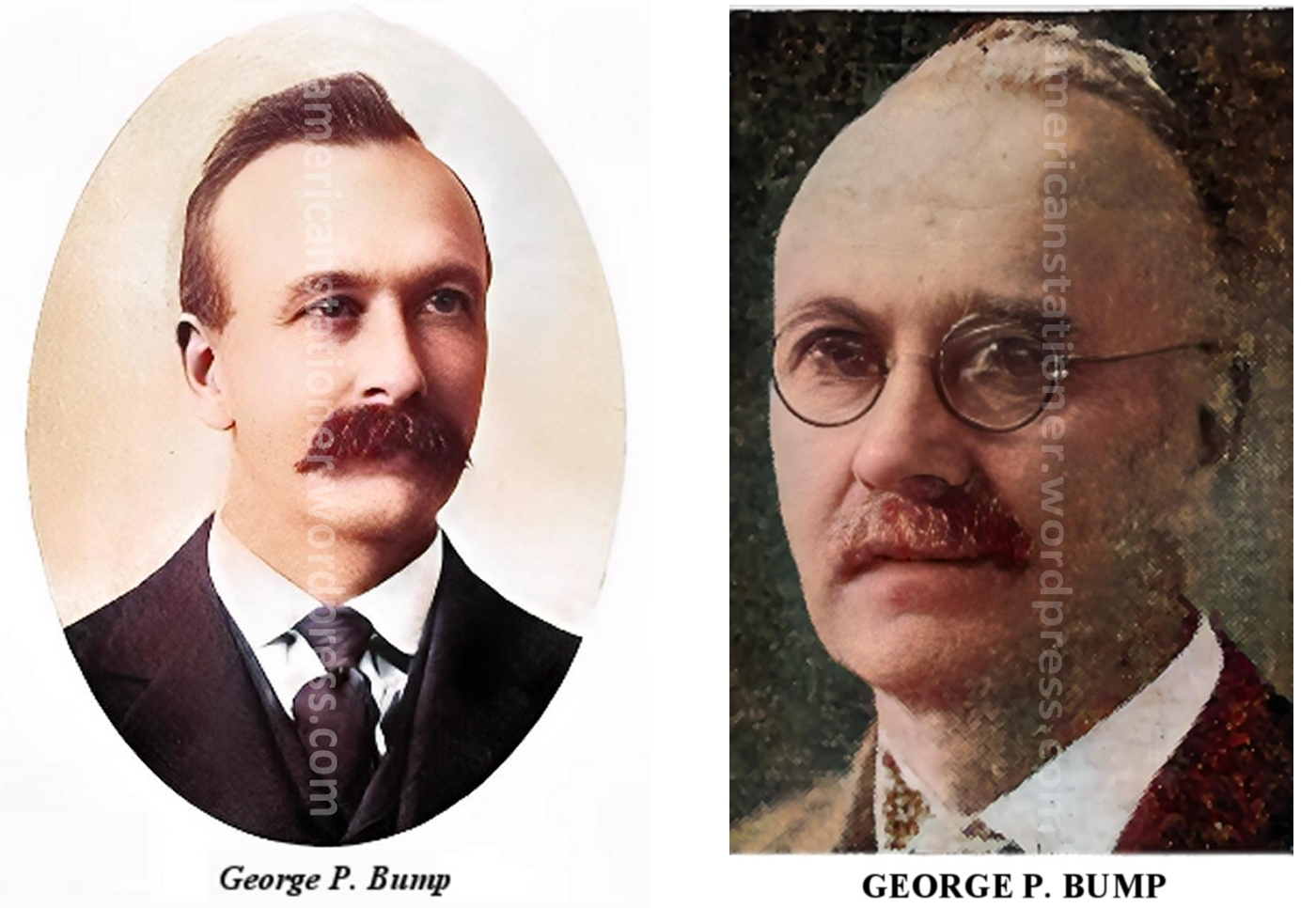
colorized photos of George Bump from 1916 and 1930
George Bump started production of the Bump Paper Fasteners in 1910 in Newton, Iowa. The first fully-functional prototype of his fastener was completed on May 14, 1909 and by the next year manufacturing began. Sometime in 1910 Bump moved operations to La Crosse, Wisconsin and in 1919 built his own factory at 1830 West Ave S, La Crosse, Wisconsin. It would remain at the location until 1956 when it finally closed.
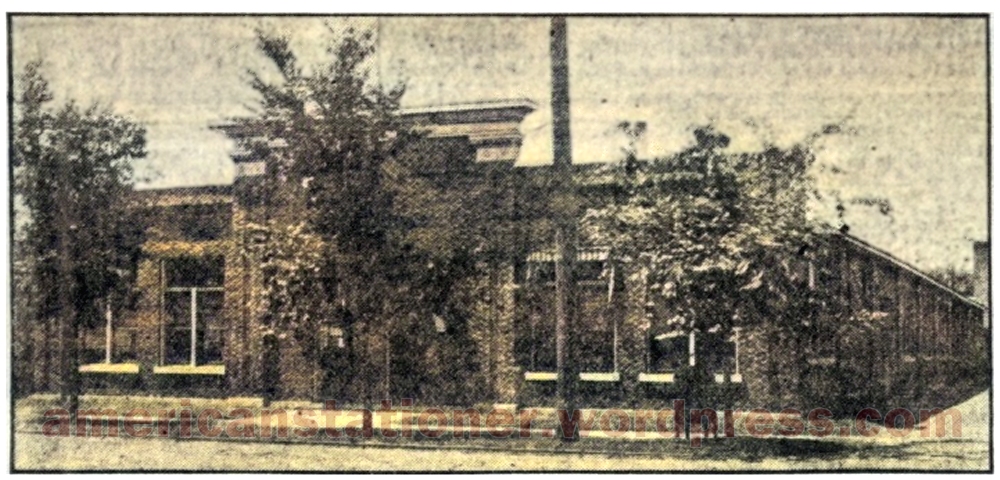
1927 colorized newspaper photo of Bump factory
When the company was first formed in 1909 it was named the Bump Perfected Paper Fastener Co. On April 20, 1914 it changed names to the Bump Paper Fastener Co. In 1930 the Bump Manufacturing Co was formed covering all of the different products being produced by that time but the Bump Paper Fastener was always stamped with “Bump Paper Fastener Co”. It was at this time another corporation purchased Bump Paper Fastener with George Bump no longer the owner of the business or patents.
During its entire production run, three models of the fastener were produced. The first model was the “model 00” which is an open plier-type which, when first introduced, had vines inscribed onto the sides of the handles. The “model 2”, a desk model, is known to have been in production in 1912. And finally, the “model 1”. The model 1 was first advertised in 1915.
Bump Paper Fasteners were advertised from 1910 to 1954. When introduced, the model 00 was $1.50 which in 2024 equates to about $50. This would have been considered a major office investment for an item like a paper fastener.
The following are the different models produced by the Bump Paper Fastener Co.
Model 00, version A
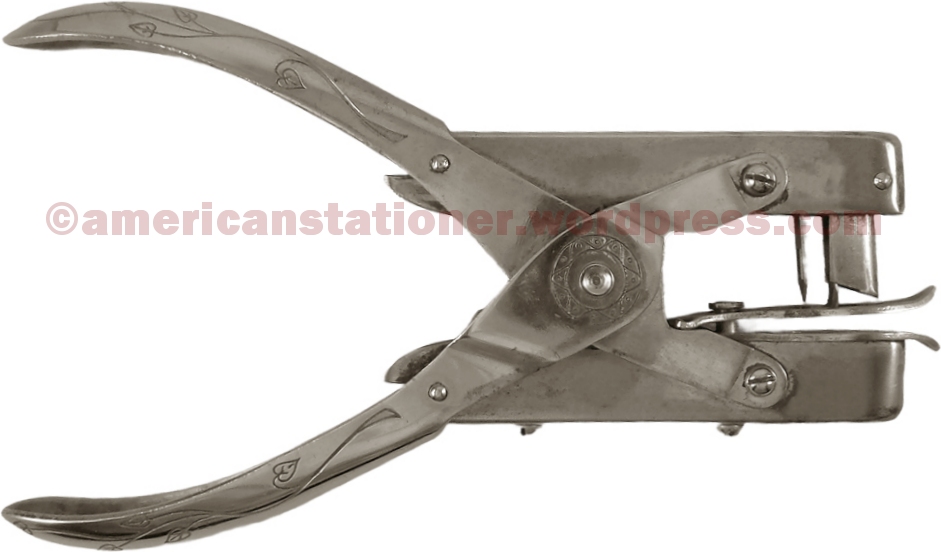
- advertised from 1910 to 1912
- measures 6.5 inches long by 3.7 inches high by .6 inches wide
- weighs 6.2 ounces
- made of 100% steel
- vine decoration on handles, rondel decoration inscribed on center pivot pin, no other markings
Model 00, version B

- advertised from 1927 to 1950, although almost definitely this version was available prior to 1927
- measures 6.5 inches long by 3.2 inches high by .6 inches wide
- weighs 6.3 ounces
- made of 100% steel
- inscribed on bottom PATD. 6-24-13
- inscribed on top BUMP PAPER FASTENER CO. LA CROSSE WIS U.S.A.
Model 1

- advertised from 1915 to 1946, but likely produced to end of the company
- measures 5.5 inches long by 2.75 inches high by .7 inches wide
- weighs 6.6 ounces
- made of 100% steel
- inscribed on top THE BUMP PAPER FASTENER CO. LA CROSSE, WIS U.S.A. PAT’D JULY 21:14
- earlier models had the company info on one side of the body and a logo on the other (see below)
- later models had the company info on both sides of the body
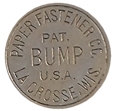
Model 2, version A

- advertised from 1912 to 1915, but may have been introduced a year or two earlier
- made of 100% steel
Model 2, version B
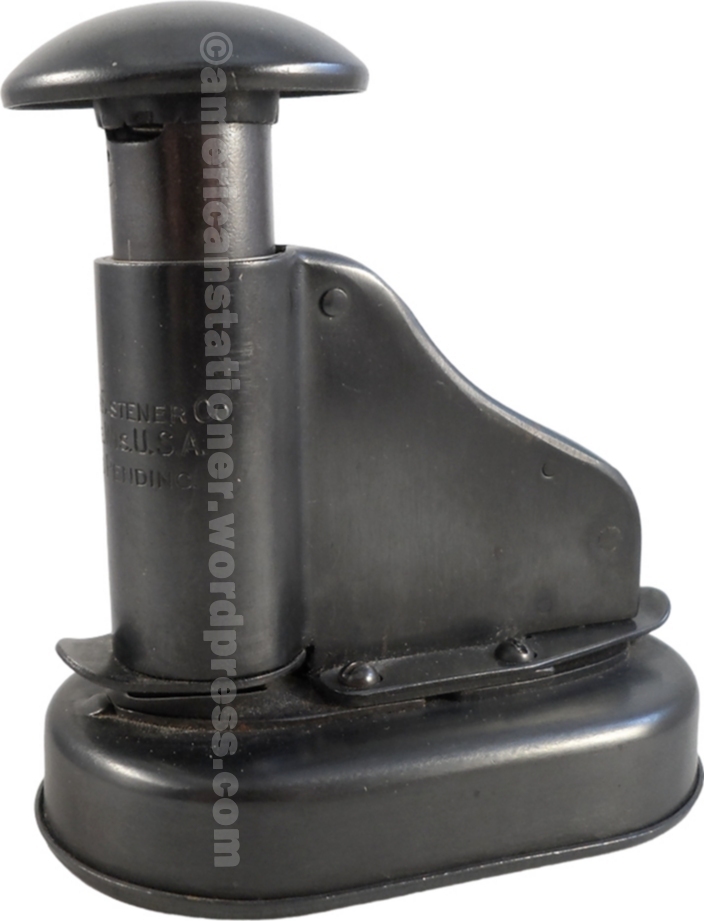
- advertised from 1916 to 1954, but may have been introduced a year or two earlier
- made of 100% steel
- measures 3.75 inches long by 4 inches high by 2 inches wide
- weighs 10.2 ounces
- includes a quarter inch paper punch on the rear of the fastener which is actuated by using the same plunger handle
- inscribed on front BUMP PAPER FASTENER CO LA CROSSE, WIS U.S.A. PATENTS PENDING. No other inscriptions
- early models nickel plated, later models chrome plated
- starting in late 1930’s, when the U.S. government started rationing metals like nickel and chromium, Bump started making the plunger handle black and eventually anodized the entire item in black. After the war it went back to being chrome plated.
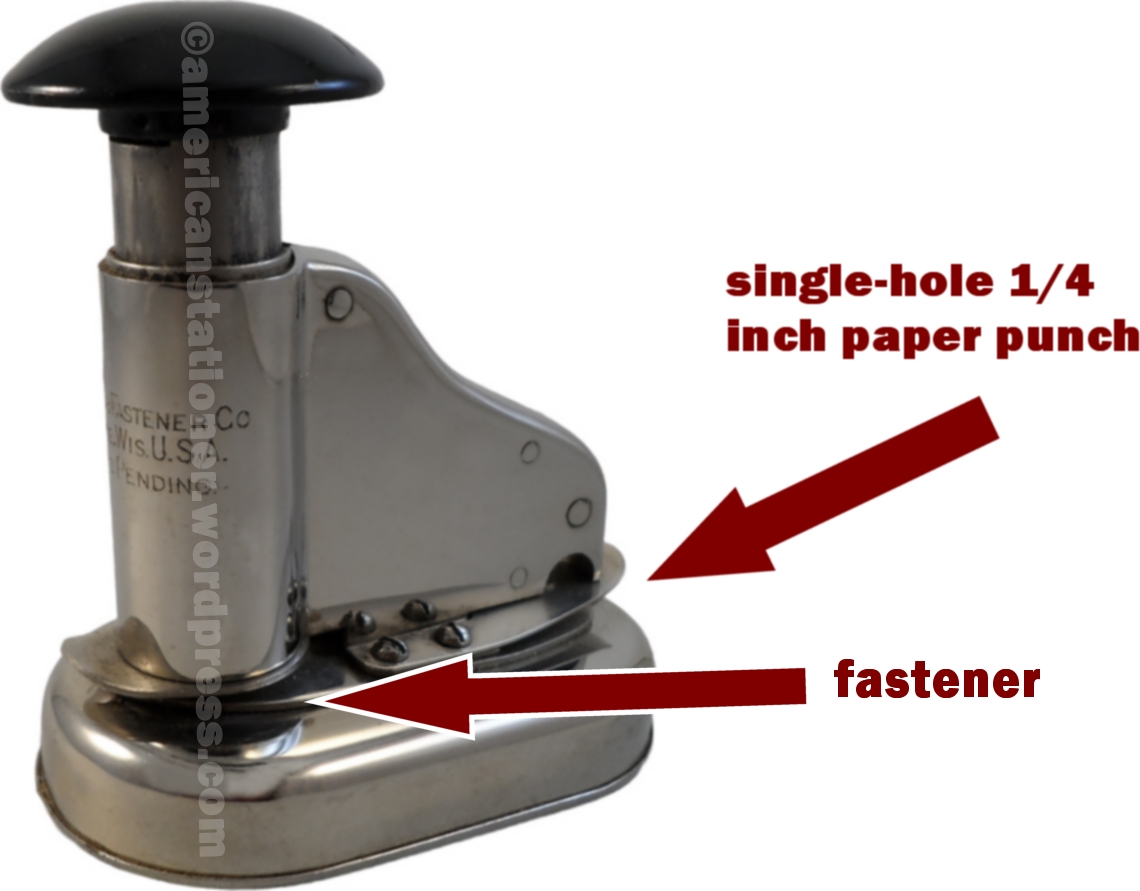
Model 1 Logos
Logo A
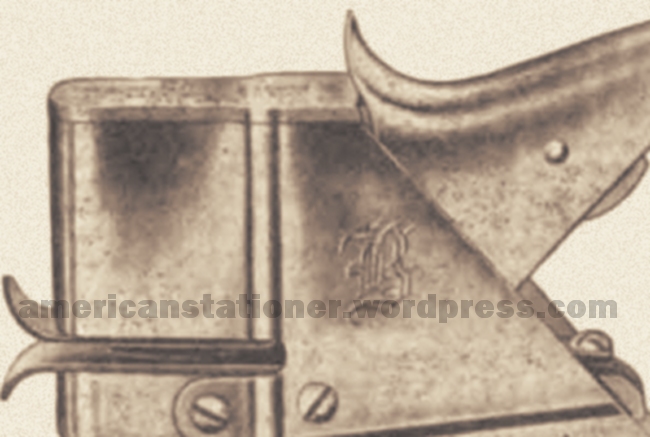
This logo was known to be used in 1915 and 1916.
Logo B

This logo was first seen in advertisements in 1916 and was used in all advertisements through the 1950’s. As the model 1 itself never changed the fact that this logo was used in advertisements was likely just a cost saving measure. It is unknown, however, when it stopped being used on the actual fastener.
Logo C
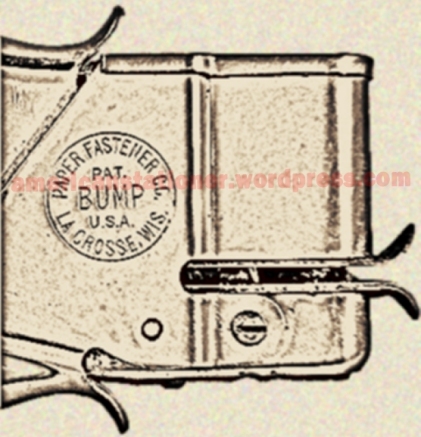
The use of this logo on both sides of the fastener was done in later years. However, it was used in conjunction with logo B with logo B one side and logo C on the other for the entire run where logo B was used.
Besides the various court cases the Bump Paper Fastener was involved in, there are other stories of interest. A check payable to the company was amongst many of the articles recovered from the wreck of the Titanic. The bank reissued the check to them for payment once they received the original. A Bump Fastener was taken on the 1928 expedition to Antarctica by Admiral Byrd. It was sent back to the company and they asked for a new one which the company honored. The fastener was said to be an excellent device and worked admirably throughout. It is unknown what happened to the Antarctic Expedition’s original fastener unfortunately.
George P. Bump was born on May 14, 1869. He died in Dakota, Minnesota on February 19, 1947 at the age of 77. He was a true pioneer who’s idea didn’t just fade away in the 1950s, but lives on today in the multitude of similar fasteners made since the 1960s. Bump-type fasteners are still made and sold today everywhere.
Patent and Other Information:
- Patent 1009644 Method of Fastening Paper Sheets and the Like (filed 05/14/1909, granted 11/21/1911
- Patent 1065903 Fastening Device (filed 05/14/1909, granted 06/24/1913)
- Patent 1104622 Machine for Fastening Paper or Like Sheets Together (filed 05/05/1913, granted 07/21/1914) improvement on patent 1104622 as stated
Notes:
- Continental Art Co, (1910, April 30), advertisement, Saturday Evening Post, page 38
- Editors, (1910, March), A New Paper Fastener, Office Appliances, page 110
- Editors, (1915, August 28), Bump’s New Paper Fastener, The American Stationer, page 16
- Bump Paper Fastener Co, (1922, February), advertisement, The American Stationer, page 206
- Editors, (1927, June 26), Paper Fastener Advertises City Internationally, La Crosse Tribune and Leader Press, page 11
- Editors, (1927, January), Something From Nothing, Geyer’s Stationer, page 240
- Editors, (1929, August 25), Bump Paper Fasteners Advertise In All Provinces of the Globe, La Crosse Tribune and Leader Press, page 7
- Editors, (1930, August 3), Corporation Takes Over George P. Bump Paper Fastener Firm, La Crosse Tribune and Leader Press, pages 1 & 6
- Editors, (1930, August 3), Story of Bump Paper Fastener Combination of Romance, Struggle, La Crosse Tribune and Leader Press, pages 1 & 6
- Sam’l Dodsworth Stationery Co Catalog, (1932), Kansas City, MO, page 32
- Utility Supply Co Catalog, (1940), Kansas City, MO, page 331
- Editors, (1947, February 20), George P. Bump, 77, Dies at Dakota, The Winona Republican-Herald, page 7
- Utility Supply Co Catalog, (1948), Kansas City, MO, page 388
- Frank A. Weeks Mfg Co Catalog, (1954), New York, NY, page 246
- Editors, (2005, January 31), Ask the Trib, La Crosse Tribune, Section B
- Editors, (2019, October 12), Bump paper fastener a Midwest innovation, La Crosse Tribune, page C3
Help support the American Stationer. The site really needs your help in order to stay alive. Please become a supporting patron by subscribing to our Patreon at www.patreon.com/americanstationer.
Visit me at https://www.facebook.com/groups/americanstationer and let’s get all nerdy about office stuff 🙂
If you enjoy the American Stationer consider purchasing one of my books at Amazon.
- STAPLERS, STAPLING MACHINES, & PAPER FASTENERS VOL 1 – E.H. HOTCHKISS COMPANY OFFICE AND INDUSTRIAL STAPLING MACHINES
- STAPLERS, STAPLING MACHINES, & PAPER FASTENERS VOL 2 – NEVA-CLOG
- NEVA-CLOG STAPLING MACHINES PRICE GUIDE: 2019 EDITION
- STAPLERS, STAPLING MACHINES, & PAPER FASTENERS VOL 3 – ACE FASTENER
You’ll get one-of-a-kind references and information you won’t find anywhere else and you’ll help me keep American Stationer going.




